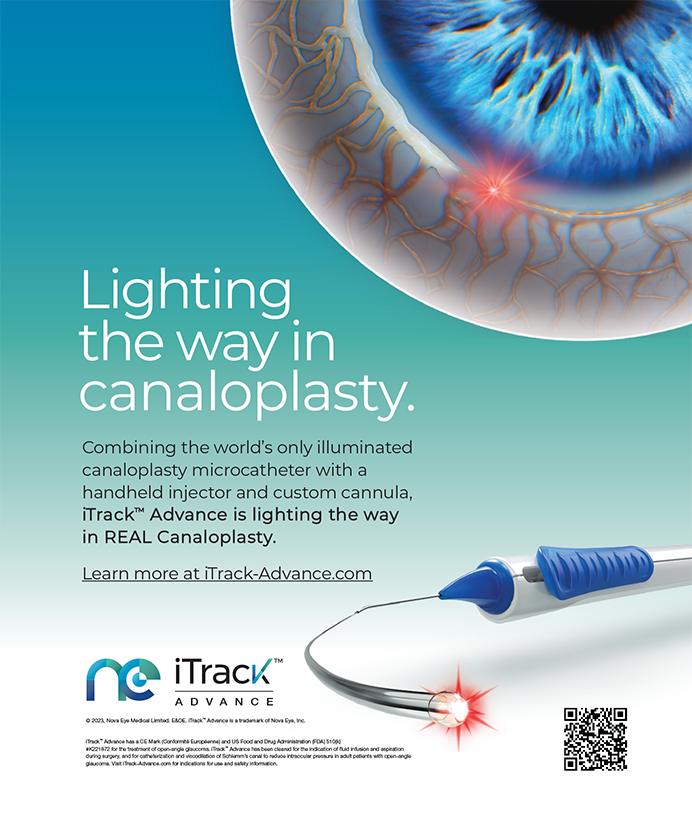The Tetraflex accommodating IOL (Lenstec, Inc., St. Petersburg, FL) is one of the exciting new technologies to which European surgeons, unlike most American surgeons, have access to as part of their surgical refractive armamentarium. Despite the small size of the lens' manufacturer, the Tetraflex accounts for more than 30 of the presbyopic IOL market in Europe (data on file with Market Scope, LLC, Manchester, MO). In addition to implanting the Tetraflex IOL as a principal investigator in the FDA trial, I also implant the Acrysof Restor IOL (Alcon Laboratories, Inc., Fort Worth, TX), Crystalens (Eyeonics, Inc., Aliso Viejo, CA), and Rezoom IOL (Advanced Medical Optics, Inc., Santa Ana, CA) in my practice.
THE TETRAFLE XIOL
Design
The Tetraflex (Figure 1) is an anteriorly vaulted, single-piece, foldable, accommodating IOL that is implanted using a custom-designed injector system through an incision as small as 3mm. The lens' optic is 5.75mm and is made of a highly biocompatible hydrophilic acrylic material. The IOL's two haptics, each with two footplates, sit posteriorly in the peripheral capsular bag. The surgeon performs his standard capsulorhexis and phacoemulsification technique are performed. Lenstec, Inc. recommends that surgeons create a 5.5- to 6.0-mm circular capsulorhexis. They should not implant the Tetraflex if an anterior capsular radial tear is created during surgery. The lens is used internationally for both cataract and refractive lensectomy surgery.
The Mechanism of Action
The mechanism of action of the Tetraflex is multifactorial. On ultrasound biomicroscopy (UBM) the lens moves forward during accommodative effort (Figures 2 and 3). I think this movement occurs due to the contraction of the ciliary muscle that loosens the zonules as well as increases vitreous pressure. In addition, the anterior surface of the optic curves more than the posterior surface during anterior vaulting of the lens. This higher radius of curvature of the lens' anterior surface increases the net refractive power of the lens as well as induces coma. The later is an important part of the normal accommodative process in the prepresbyopic phakic eye. The accommodative effect of the lens may be seen using three-dimensional ray tracing, which shows increased depth of focus and mean and maximum myopia in eyes implanted with the Tetraflex during the accommodative effort (D. Sanders, MD, oral communication, December 2005) (Figure 4).
US Clinical Trial
The Tetraflex IOL is currently in phase 3 FDA clinical trials in seven centers in the US. To date, more than 150 lenses have been implanted in this country, with 53 of eyes having 6 months or more of follow-up (data on file with Lenstec, Inc.). Of those 53 eyes, 60 achieved a distance UCVA of 20/20 or better, and 90 achieved a UCVA of 20/40 or better. In terms of evaluating the near performance of any presbyopic lens, distance-corrected near vision is considered the gold standard. Fifty-five percent of eyes demonstrated a monocular distance-corrected near vision of J5 (print size of stock quotes) or better, and 90 have a distance-corrected near vision of J8 (standard newspaper print) or better. European data of near visual function show that the near performance of Tetraflex is even better when the lens is implanted bilaterally versus monocularly (data on file with Lenstec, Inc.). In terms of accommodative amplitude in the FDA study, 100 of eyes had at least 2.00D, and 69 had at least 3.00D of accommodation at 6 months postoperatively using the "Push Down" amplitude of accommodation test. Currently, none of the patients implanted with the Tetraflex, either domestically or internationally, have experienced any capsular issues.
My experience as a principal investigator in the FDA trial of this lens has been excellent. So far, I have implanted 35 of these IOLs. The lens is simple to implant, has none of the visual side effects (such as glare, halo, and loss of contrast sensitivity) of multifocal lenses, and is consistently giving my patients functional near vision without correction. Because there is a single point of focus through all distances, the quality of vision through the lens is excellent. I consider this lens equivalent in distance performance to any monofocal lens that I use with the fringe benefit of improved near vision. Like any accommodative lens, however, I do not promise that all patients will throw away their glasses. Some patients achieve lesser accommodative effect and may require near spectacles part of the time, particularly with low lighting and low-contrast print. I have found that patients with shorter axial lengths tend to have better subjective near vision with the Tetraflex than patients with longer axial lengths.
CONCLUSION
Thus far, I have not noted any complaints of glare or halos at night in my Tetraflex patients, which is likely due to both the monofocal nature of the lens as well as its 5.75-mm optic. Although I have needed to perform a YAG posterior capsulotomy on only a few eyes after the IOL's implantation, the laser does not seem to negatively affect accommodation, and all lenses have remained in perfect position postoperatively.
Many different lenses are available to treat presbyopia in the US, including both monofocal and multifocal IOLs. European surgeons have access to many exciting ophthalmic technologies not currently available here. One of these, the Tetraflex IOL, shows significant promise in helping the surgeon to deal with the presbyopic patient. I believe this lens, when and if approved by the FDA, will be the presbyopic IOL of choice.
Paul J. Dougherty, MD, is Clinical Instructor of Ophthalmology at the Jules Stein Eye Institute, University of California, Los Angeles, and Medical Director at Dougherty Laser Vision in Los Angeles and Camarillo, California. He receives travel support from Lenstec, Inc., and is a paid consultant for Alcon Laboratories, Inc. Dr. Dougherty may be reached at (805) 987-5300; info@doughertylaservision.com.


